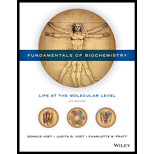
(a)
To draw: The product that is formed when the bacteria that live in the large intestine metabolizes glycocholic acid using amidases and hydroxylases.
Concept introduction: Glycocholic acid is also known as cholylglycine, which is a crystalline bile acid. It is involved in the emulsification of fats. In the bile of mammals, cholylglycine occurs as a salt in the bile of mammals. The anion of glycocholine is called glycocholate.
(b)
To compare: The solubility of glycocholic acid and the product formed when the bacteria that live in the large intestine metabolizes glycocholic acid using amidases and hydroxylases.
Concept introduction: Glycocholic acid is also known as cholylglycine, which is a crystalline bile acid. It is involved in the emulsification of fats. In the bile of mammals, cholylglycine occurs as a salt in the bile of mammals. The anion of glycocholine is called glycocholate.
(c)
To determine: Whether the change in the bile acid solubility makes it less toxic to bacteria.
Concept introduction: Bile acids are the steroid acids present in the bile. They are found in the bile of mammals and other vertebrates. Bile acids are conjugated with taurine or glycine in the liver. Bile acids are amphipathic molecules having a hydrophobic and hydrophilic region.
Want to see the full answer?
Check out a sample textbook solution
Chapter 20 Solutions
Fundamentals of Biochemistry: Life at the Molecular Level
- 1. Conceptual questions a. What dimensionless group describes the relative importance of convection versus diffusion. Explain the physical basis of this group. b. For mass transfer from a flowing fluid to a reactive surface, explain how convection increases the flux of solute to the surface.arrow_forwardAssessment +1501 pts /1600 Resources Solution ? Hint Sub bo Each pictured Lewis structure is invalid. Identify the error in each case. O Macmillan Learning :0▬▬0: Answer Bank wrong electron total :0- :F======F: octet-rule violation N :0:arrow_forward[s] mM V (M/s) Uninhibited 0.333 1.65 x 107 1.05 x 107 V (M/s) x 10' Inhibitor A V (M/s) x 107 Inhibitor B 0.794 x 107 0.40 1.86 x 107 1.21 x 107 0.893 x 107 0.50 2.13 x 107 1.43 x 107 1.02 x 107 0.666 2.49 x 107 1.74 x 107 1.19 x 107 1.0 2.99 x 107 2.22 x 107 1.43 x 107 2.0 3.72 x 107 3.08 x 107 1.79 x 107arrow_forward
- For a Michaelis-Menten reaction, k₁-5 x 10'/M-s, k.-2 x 10%/s, and k₂-4 x 10²/s. a) Calculate the Ks and KM for this reaction. b) Does substrate binding achieve equilibrium or steady state?arrow_forwardAssume that an enzyme-catalyzed reaction follows the scheme shown: E+S SES →E + P k₁ = 1 x 109/M-s k-1=2.5 x 10%/s k₂ = 3.4 x 107/s What is the dissociation constant for the enzyme-substrate, K,? What is the Michaelis constant, Km, for this enzyme? What is the turnover number, Keat, for this enzyme? What is the catalytic efficiency for the enzyme? If the initial Et concentration is 0.25mM, what is Vmax?arrow_forwardAn enzyme lowers the activation energy, (AG) of a reaction from 50.0 kcal/mol to 40.0 kcal/mol. Calulate the catalytic power at 310K. (R-1.987x10 kcal/mol)arrow_forward
- Draw a typical axodendritic synapse, including a specific neurotransmitter of your choice, its associated postsynaptic receptors (indicating whether they are ionotropic or metabotropic), and any associated reuptake transporters or degradation enzymes. Please include a description of what specific steps would occur as an action potential reaches the axonal terminal.arrow_forwardGive a full arrow pushing mechanism of the spontaneous redox reaction between NAD+/NADH and oxaloacetate/malate. Please include diagram drawing of the mechanism! (Thank You!)arrow_forward18. Which one of the compounds below is the major organic product obtained from the following series of reactions? 1. BH3 2. H2O2, NaOH H₂CrO4 CH2N2 oro ororos A B C D Earrow_forward
- 17. Which one of the compounds below is the major organic product obtained from the following series of reactions? CI benzyl alcohol OH PBr3 Mg 1. CO2 SOCl2 ? ether 2. H+, H₂O CI Cl HO OH CI Cl A B C D Earrow_forward14. What is the IUPAC name of this compound? A) 6-hydroxy-4-oxohexanenitrile B) 5-cyano-3-oxo-1-pentanol C) 5-cyano-1-hydroxy-3-pentanone D) 1-cyano-5-hydroxy-3-pentanone E) 5-hydroxy-3-oxopentanenitrile HO. CNarrow_forward13. What is the IUPAC name of this compound? A) 5-hydroxy-3,3-dimethylpentanoic acid B) 3,3-dimethylpentanoic acid C) 3,3-dimethyl-1-oxo-1,5-pentanediol D) 1,5-dihydroxy-3,3-dimethylpentanal E) 4-hydroxy-2,2-dimethylbutanoic acid HO OHarrow_forward
 BiochemistryBiochemistryISBN:9781319114671Author:Lubert Stryer, Jeremy M. Berg, John L. Tymoczko, Gregory J. Gatto Jr.Publisher:W. H. Freeman
BiochemistryBiochemistryISBN:9781319114671Author:Lubert Stryer, Jeremy M. Berg, John L. Tymoczko, Gregory J. Gatto Jr.Publisher:W. H. Freeman Lehninger Principles of BiochemistryBiochemistryISBN:9781464126116Author:David L. Nelson, Michael M. CoxPublisher:W. H. Freeman
Lehninger Principles of BiochemistryBiochemistryISBN:9781464126116Author:David L. Nelson, Michael M. CoxPublisher:W. H. Freeman Fundamentals of Biochemistry: Life at the Molecul...BiochemistryISBN:9781118918401Author:Donald Voet, Judith G. Voet, Charlotte W. PrattPublisher:WILEY
Fundamentals of Biochemistry: Life at the Molecul...BiochemistryISBN:9781118918401Author:Donald Voet, Judith G. Voet, Charlotte W. PrattPublisher:WILEY BiochemistryBiochemistryISBN:9781305961135Author:Mary K. Campbell, Shawn O. Farrell, Owen M. McDougalPublisher:Cengage Learning
BiochemistryBiochemistryISBN:9781305961135Author:Mary K. Campbell, Shawn O. Farrell, Owen M. McDougalPublisher:Cengage Learning BiochemistryBiochemistryISBN:9781305577206Author:Reginald H. Garrett, Charles M. GrishamPublisher:Cengage Learning
BiochemistryBiochemistryISBN:9781305577206Author:Reginald H. Garrett, Charles M. GrishamPublisher:Cengage Learning Fundamentals of General, Organic, and Biological ...BiochemistryISBN:9780134015187Author:John E. McMurry, David S. Ballantine, Carl A. Hoeger, Virginia E. PetersonPublisher:PEARSON
Fundamentals of General, Organic, and Biological ...BiochemistryISBN:9780134015187Author:John E. McMurry, David S. Ballantine, Carl A. Hoeger, Virginia E. PetersonPublisher:PEARSON





